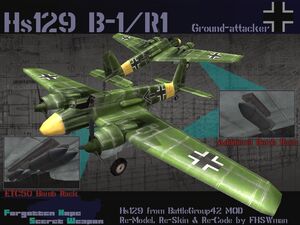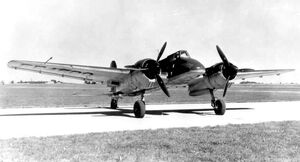The Henschel Hs 129 fighter-bomber was built to a 1937 German specification for a twin-engine close-support aircraft with considerable armor protection for pilot and crew and the ability to field twin 20mm cannons at least. The resulting competition left a Focke-Wulf design (the Fw 189C) and the Henschel Hs 129 design as finalists with the nod going to the Henschel firm.
The Hs 129 was by far a perfect aircraft for close-support duty. It was relatively underpowered - even with the twin Gnome-Rhone radial engines - and the cockpit small enough to cram just one person. Visibility was reported to be far from superior though something about the overall design likened the Reichsluftahrtministerium to it. Armament consisted of two nose-mounted MG FF 20mm cannons and two MG 17 7.92mm machine guns. The Hs 129 was fielded in the East against the might of the Soviet Union by design, though later they were consequently fielded throughout North Africa and Europe (post D-Day) by necessity.
By all accounts, performance results of the system proved sublime, with the Hs 129 accounting for the destruction of hundreds of Soviet tanks, particularly at the Battle of Kursk in 1943. The Hs 129 proved to be a viable asset in the close-support role, capable of engaging even the most stubborn of Allied armor with an array of cannons, machine guns and bombs.
Hs 129 B-1/R1[]
The production Hs 192B-1 series went into service first with 4./SchG 1 at Lippstadt in April 1942 and also became operational on the Eastern front, where the type was to be used most widely, although it served also in North North Africa, Italy and in France after the D-Day landings. Sub-variants of the M 129B-1 series included the Hs 129B-1/R1 with additional offensive armament in the form of two 110 lbs (50 kg) bombs or 96 anti-personnel bombs; the Hs 129B-1/R2 with a 30-mm MK 101 cannon beneath the fuselage; the Hs 129B-1/R3 with four extra MG 17 machine-guns; the Hs 129B-1/R4 with an ability to carry one 551 lbs (250 kg) bomb instead of the Hs 129B-1/R1's bombload; and the Hs 129B-1/R5 which incorporated an Rb 50/30 camera installation for reconnaissance duties.
Hs 129 B-2/R2[]
The Hs 129B-2 was similar to the B-1, but with tropical equipment. Even before the disastrous debut of the B-1 in North Africa in November 1942 Henschel had been working on producing a tropicalised version of the aircraft. This involved fitting BMW air-filters and a new oil filter. Tests with one of the B-0s in March-May 1942 proved that the equipment wordked, and in May it was decided to end production of the Hs 129B-1 after the 50th machine had been completed, and switch to the B-2, complete with the new filters.
As with the B-1 the B-2 could carry the 30mm Mk 101 or 103 cannon or four MG 17 machine guns under the fuselage. The vast majority of Hs 129s produced would be B-2s.
Hs 129 B-3[]
Even by late 1942 complaints started about the MK 103 against newer versions of the T-34 tanks. One obvious solution would be to use the larger 37 mm gun, adapted from an anti-tank gun that had recently been abandoned by the army. These guns had already been converted into pod-mounted weapons for the Ju 87 and found to be a fearsome weapon. When mounted on the Hs 129 the empty area behind the cockpit could be used for ammunition storage, which would address the only problem with the Ju 87's mounting, limited ammunition.
But for some reason the Luftwaffe decided to skip over this gun for the Hs 129, and install a gigantic 75 mm Bordkanone gun from the Panzer IV (Pak 40). The resulting system was able to knock out any tank in the world, but the weight slowed the already poor performance of the plane to barely flyable in this new Hs 129 B-3 version.
Trivia[]
The Henschel model is provided by BattleGroup42 mod team under a content trade agreement.
| ||||||||||||||||||||||||||||||||||||||

















